Solar eclipse of July 2, 2019
A total solar eclipse occurred at the ascending node of the Moon's orbit on July 2, 2019, with an eclipse magnitude of 1.0459. Totality was visible from the southern Pacific Ocean east of New Zealand to the Coquimbo Region in Chile and Central Argentina at sunset, with the maximum of 4 minutes 32 seconds visible from the Pacific Ocean. The Moon was only 2.4 days before perigee (Perigee on July 5, 2019), making it fairly large.
| Solar eclipse of July 2, 2019 | |
|---|---|
 Totality viewed from La Serena, Chile | |
 Map | |
| Type of eclipse | |
| Nature | Total |
| Gamma | -0.6466 |
| Magnitude | 1.0459 |
| Maximum eclipse | |
| Duration | 273 sec (4 m 33 s) |
| Coordinates | 17.4°S 109°W |
| Max. width of band | 201 km (125 mi) |
| Times (UTC) | |
| Greatest eclipse | 19:24:08 |
| References | |
| Saros | 127 (58 of 82) |
| Catalog # (SE5000) | 9551 |
Another solar eclipse occurred one lunar year after this eclipse, on June 21, 2020. A total solar eclipse crossed this region of the Earth on December 14, 2020.
Images
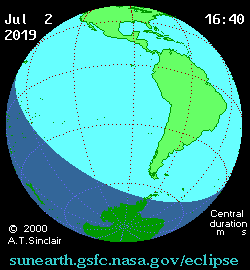

Visibility
A solar eclipse occurs when the Moon passes between Earth and the Sun, thereby totally or partly obscuring the image of the Sun for a viewer on Earth. A total solar eclipse occurs when the Moon's apparent diameter is larger than the Sun's, blocking all direct sunlight, turning day into darkness. Totality occurs in a narrow path across Earth's surface, with the partial solar eclipse visible over a surrounding region thousands of kilometres wide.
Following the North American solar eclipse of August 21, 2017, Astronomers Without Borders collected eclipse glasses for redistribution to Latin America and Asia for the 2019 eclipses.[1]
Totality travelled over areas with low levels of humidity and light pollution, allowing for very good observations. Several major observatories experienced totality, including the European Southern Observatory.[2][3]
Oeno Island
The first land surface and the only Pacific island from which totality would have been visible is Oeno Island, an uninhabited atoll in the Pitcairn Islands.[3]
Chile
Totality was visible in a large portion of Coquimbo Region and small parts of Atacama Region. Cities in the path include La Serena and La Higuera. Approximately 300,000 people visited La Serena to view the event.[2] Tickets to view the eclipse from the European Southern Observatory were sold for US$2000 each.[3]
Argentina
Totality was visible in the provinces of San Juan, La Rioja, San Luis, Córdoba, Santa Fe, and Buenos Aires. Cities in the path include San Juan and Río Cuarto.[3] The path of the totality was finishing at the Samborombon Bay, where the eclipsed suunset was observed from San Clemente del Tuyu.

Another 130 km further south-east, the local inhabitants could watch the total solar eclipse plunge below the horizon. There are reports from the Atlantic coast, where the fleeting umbra was recorded in the Santa Teresita and Pinamar resorts.[4]
Gallery
.jpg.webp) Eclipse progression from Huechuraba, Chile
Eclipse progression from Huechuraba, Chile
 Totality over La Silla Observatory, Chile
Totality over La Silla Observatory, Chile.jpg.webp) Partial from Temuco, Chile, 19:42 UTC
Partial from Temuco, Chile, 19:42 UTC.jpg.webp) Partial from Buenos Aires, Argentina, 20:10 UTC
Partial from Buenos Aires, Argentina, 20:10 UTC Totality as seen from La Silla Observatory, 20:39 UTC
Totality as seen from La Silla Observatory, 20:39 UTC.jpg.webp) From Ñuñoa, Chile, 20:41 UTC, near greatest eclipse
From Ñuñoa, Chile, 20:41 UTC, near greatest eclipse_(48199449761).jpg.webp) Time-lapse image from Marcos Juárez, Argentina
Time-lapse image from Marcos Juárez, Argentina_(processed).jpg.webp)
 The total solar eclipse diamond ring from ESO's La Silla Observatory on 2 July 2019 at the moment when most of its face is occulted by the moon. Image was taken by Mahdi Zamani by the NTT telescope viewpoint.
The total solar eclipse diamond ring from ESO's La Silla Observatory on 2 July 2019 at the moment when most of its face is occulted by the moon. Image was taken by Mahdi Zamani by the NTT telescope viewpoint.
Related eclipses
Eclipses of 2019
- A partial solar eclipse on January 6.
- A total lunar eclipse on January 21.
- A total solar eclipse on July 2.
- A partial lunar eclipse on July 16.
- An annular solar eclipse on December 26.
Tzolkinex
- Preceded: Solar eclipse of May 20, 2012
- Followed: Solar eclipse of August 12, 2026
Half-Saros cycle
- Preceded: Lunar eclipse of June 26, 2010
- Followed: Lunar eclipse of July 6, 2028
Tritos
- Preceded: Solar eclipse of August 1, 2008
- Followed: Solar eclipse of June 1, 2030
Solar Saros 127
- Preceded: Solar eclipse of June 21, 2001
- Followed: Solar eclipse of July 13, 2037
Inex
- Preceded: Solar eclipse of July 22, 1990
- Followed: Solar eclipse of June 11, 2048
Triad
- Preceded: Solar eclipse of August 31, 1932
- Followed: Solar eclipse of May 3, 2106
Solar eclipses of 2018–2021
This eclipse is a member of a semester series. An eclipse in a semester series of solar eclipses repeats approximately every 177 days and 4 hours (a semester) at alternating nodes of the Moon's orbit.[5]
Note: Partial solar eclipses on February 15, 2018, and August 11, 2018, occurred during the previous semester series.
| Solar eclipse series sets from 2018–2021 | ||||||
|---|---|---|---|---|---|---|
| Ascending node | Descending node | |||||
| Saros | Map | Gamma | Saros | Map | Gamma | |
| 107 | 2017 July 23 | -2.14244 | 112 | 2018 January 17 | 1.78677 | |
117.jpg.webp) Partial from Melbourne, Australia | 2018 July 13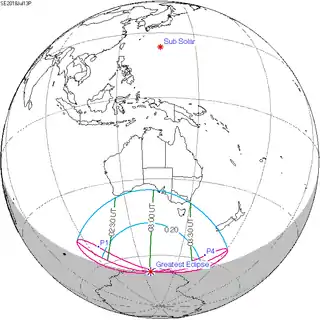 Partial |
-1.35423 | 122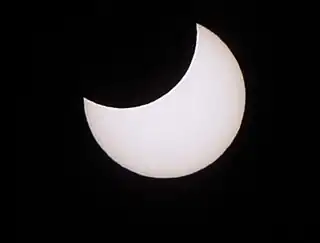 Partial from Nakhodka, Russia | 2019 January 6 Partial |
1.14174 | |
127 La Serena, Chile | 2019 July 2 Total |
-0.64656 | 132.jpg.webp) Jaffna, Sri Lanka | 2019 December 26 Annular |
0.41351 | |
137 Beigang, Yunlin, Taiwan | 2020 June 21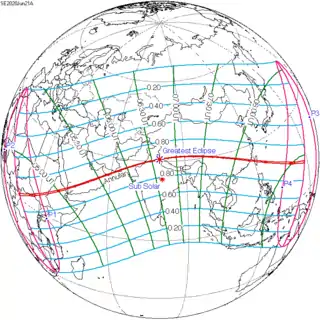 Annular |
0.12090 | 142 Gorbea, Chile | 2020 December 14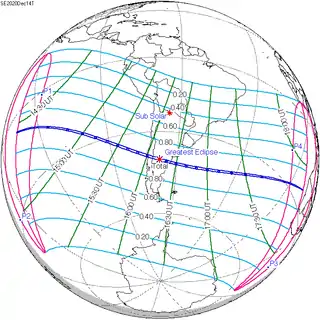 Total |
-0.29394 | |
| 147 | 2021 June 10 Annular |
0.91516 | 152 | 2021 December 4 Total |
-0.95261 | |
| 157 | 2022 May 30 | 1.65174 | 162 | 2022 November 23 | -1.69875 | |
Saros 127
It is a part of Saros cycle 127, repeating every 18 years, 11 days, containing 82 events. The series started with partial solar eclipse on October 10, 991 AD. It contains total eclipses from May 14, 1352 through August 15, 2091. There are no annular eclipses in this series. The series ends at member 82 as a partial eclipse on March 21, 2452. The longest duration of totality was 5 minutes, 40 seconds on August 30, 1532. All eclipses in this series occurs at the Moon’s ascending node.[6]
| Series members 52–68 occur between 1901 and 2200 | ||
|---|---|---|
| 52 | 53 | 54 |
 April 28, 1911 |
 May 9, 1929 |
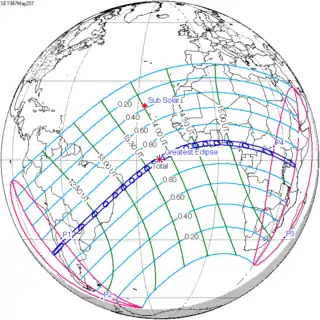 May 20, 1947 |
| 55 | 56 | 57 |
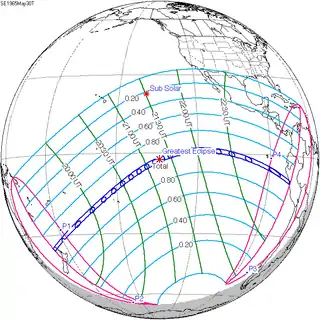 May 30, 1965 |
 June 11, 1983 |
 June 21, 2001 |
| 58 | 59 | 60 |
 July 2, 2019 |
 July 13, 2037 |
 July 24, 2055 |
| 61 | 62 | 63 |
 August 3, 2073 |
 August 15, 2091 |
August 26, 2109 (Partial) |
| 64 | 65 | 66 |
| September 6, 2127 (Partial | September 16, 2145 (Partial) | September 28, 2163 (Partial) |
| 67 | 68 | |
| October 8, 2181 (Partial) | October 19, 2199 (Partial) | |
Inex series
This eclipse is a part of the long period inex cycle, repeating at alternating nodes, every 358 synodic months (≈ 10,571.95 days, or 29 years minus 20 days). Their appearance and longitude are irregular due to a lack of synchronization with the anomalistic month (period of perigee). However, groupings of 3 inex cycles (≈ 87 years minus 2 months) comes close (≈ 1,151.02 anomalistic months), so eclipses are similar in these groupings.
In the 19th century:
- Solar Saros 120: Total Solar Eclipse of 1816 Nov 19
- Solar Saros 121: Hybrid Solar Eclipse of 1845 Oct 30
- Solar Saros 122: Annular Solar Eclipse of 1874 Oct 10
| Inex series members between 1901 and 2100: | ||
|---|---|---|
 September 21, 1903 (Saros 123) |
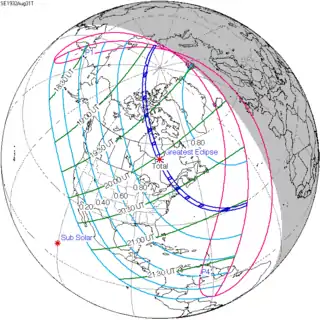 August 31, 1932 (Saros 124) |
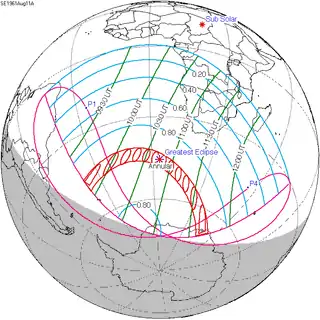 August 11, 1961 (Saros 125) |
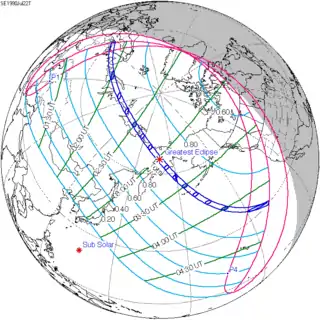 July 22, 1990 (Saros 126) |
 July 2, 2019 (Saros 127) |
 June 11, 2048 (Saros 128) |
 May 22, 2077 (Saros 129) |
||
In the 22nd century:
- Solar Saros 130: Total Solar Eclipse of 2106 May 3
- Solar Saros 131: Annular Solar Eclipse of 2135 Apr 13
- Solar Saros 132: Hybrid Solar Eclipse of 2164 Mar 23
- Solar Saros 133: Total Solar Eclipse of 2193 Mar 03
Metonic series
The metonic series repeats eclipses every 19 years (6939.69 days), lasting about 5 cycles. Eclipses occur in nearly the same calendar date. In addition, the octon subseries repeats 1/5 of that or every 3.8 years (1387.94 days). All eclipses in this table occur at the Moon's ascending node.
| 21 eclipse events, progressing from south to north between July 1, 2000 and July 1, 2076 | ||||
|---|---|---|---|---|
| July 1–2 | April 19–20 | February 5–7 | November 24–25 | September 12–13 |
| 107 | 109 | 111 | 113 | 115 |
| July 1, 1981 | April 20, 1985 | February 6, 1989 | November 24, 1992 | September 12, 1996 |
| 117 | 119 | 121 | 123 | 125 |
 July 1, 2000 |
 April 19, 2004 |
 February 7, 2008 |
 November 25, 2011 |
 September 13, 2015 |
| 127 | 129 | 131 | 133 | 135 |
 July 2, 2019 |
 April 20, 2023 |
 February 6, 2027 |
 November 25, 2030 |
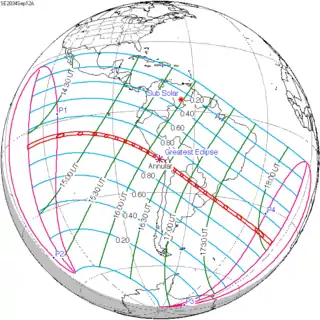 September 12, 2034 |
| 137 | 139 | 141 | 143 | 145 |
 July 2, 2038 |
 April 20, 2042 |
 February 5, 2046 |
 November 25, 2049 |
 September 12, 2053 |
| 147 | 149 | 151 | 153 | 155 |
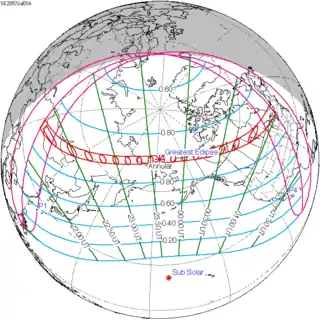 July 1, 2057 |
 April 20, 2061 |
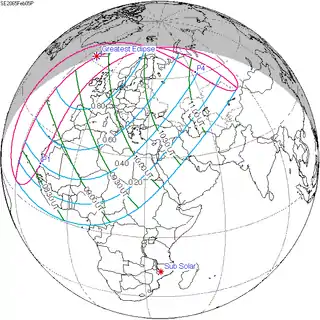 February 5, 2065 |
 November 24, 2068 |
 September 12, 2072 |
| 157 | 159 | 161 | 163 | 165 |
 July 1, 2076 |
April 19, 2080 | February 6, 2084 | November 25, 2087 | September 13, 2091 |
References
- Cooper, Gael (2017-08-22). "Wait! Dig those eclipse glasses out of the garbage Here comes the sun. Astronomers Without Borders will be collecting the protective eyewear for use in future eclipses worldwide". Retrieved 2017-08-27.
- "Total solar eclipse: thousands in Chile and Argentina marvel at 'something supreme'". The Guardian. 2019-07-02. ISSN 0261-3077. Retrieved 2019-07-02.
- "Total solar eclipse hits South America". BBC News. 2019-07-02. Retrieved 2019-07-02.
- "Solar eclipse below the horizon 2019 – the World's first webcam observation". MkrGeo. 17 February 2020. Retrieved 10 October 2020.
- van Gent, R.H. "Solar- and Lunar-Eclipse Predictions from Antiquity to the Present". A Catalogue of Eclipse Cycles. Utrecht University. Retrieved 6 October 2018.
- "Solar Saros series 127". NASA Goddard Space Flight Center. NASA. Retrieved 2 November 2017.
Additional sources
- Earth visibility chart and eclipse statistics Eclipse Predictions by Fred Espenak, NASA/GSFC
External links
| Wikimedia Commons has media related to Solar eclipse of 2019 July 2. |
- solar-eclipse.de: The total solar eclipse of 07/02/2019
- eclipseportal.com: Total Solar Eclipse July, 02, 2019
- JulyEclipse.com has free educational materials aimed at teaching children about the July 2019 Solar Eclipse. They are available in English, Spanish, and Portuguese.
.jpg.webp)

